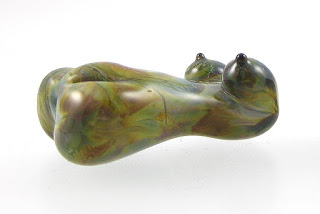1 - Plain, 2 - Plain (reduced), 3 - w/ Silver Leaf, 4 - w/ Silver Leaf (reduced & encased), 5 - w/ Silver Glass Frit (reduced), 6 - w/ TerraNova2 Frit, 7 & 8 - w/ Tuxedo, Copper Green, Opal Yellow, Ivory, and Peace
Effetre Mosaic Blue is an extremely dense medium blue colour that looks darker and darker, the thicker it is layered. Unlike its friend Mosaic Green, this colour is not terribly reactive, and does not spread or web at all when used on top of other colours. I found this a bit disappointing on a mental level, since I wanted there to be something similar about two colours with such similar names.
This colour is very stiff, and very dense. It's not a great colour for overdotting flower petals (at least I don't think so) in encased florals because the result doesn't have a lot of depth because not much light gets through the Mosaic Blue.
Where this colour really shines is when it is used with silver. You can see here that both of my silver leaf beads are interesting-looking. The bead on the left has a greyish silver film over it that is made up of hundreds of little microdots of silver. The bead on the right was reduced and encased, and the silver has gone bluish where it touches the Mosaic Blue, and silvery and shiny where it does not. Pretty!
Mosaic Blue is also a good base colour for silver glasses. It doesn't compete with them, and the reduction colours and striking colours do well on top of it.
And weirdly, there is not a single thing to say about these beads. Usually there is a lot of action here, but I can't detect a single reaction between any of these colour combinations apart from (maybe) a little bleeding of Mosaic Blue into Peace, and a gentle separation of Peace over Mosaic Blue. These are pretty typical reactions for Peace, and not in any way unique to, or spectacular with, this colour.
Here are two sets using Mosaic Blue (I didn't bother making a goddess bead, since it would have just been an almost-black bead because this colour is so dense). One is with Antique Green, and the other is with Ivory.























